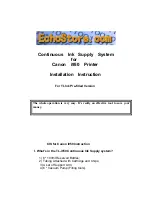
5-11
62-11848
a. Testing a cab command cable that is already installed on the unit and routed into the truck cab requires the
use of both pieces of the diagnostic tool.
b. Unplug the cab command cable from the microprocessor and also from the back of the cab command module.
c. Plug one end of the cable into the primary tool and the other end into the remote tool.
d. Begin the test by turning on the power switch and observing the sequence of green lights. As each circuit is
tested, the corresponding light is illuminated. If a fault is found in the cable, the light that corresponds to that
particular circuit is not illuminated.
e. To test a cable that is not installed on a unit, simply plug each end of the cable into the primary tool and per-
form the test as above.
5.14 MICROPROCESSOR
WARNING
!
Under no circumstances should anyone attempt to repair the microprocessor module or Cab
Command! Should a problem develop with these components, contact your nearest Carrier
Transicold dealer for replacement.
Although there is less danger of electrical static discharge (ESD) damage in the outdoor environment, where the
processor is likely to be handled, proper board handling techniques should be stressed. Boards should always be
handled by their edges, in much the same way one would handle a photograph. This not only precludes the possi-
bility of ESD damage, but also lowers the possibility of physical damage to the electronic components. Although
the microprocessor boards are fairly rugged when assembled, they are more fragile when separated and should
always be handled carefully.
When welding is required on the unit frame, or on the front area of the truck, ALL wiring to the microprocessor
MUST be disconnected. When welding is performed on other areas of the truck and van, the welder ground con-
nection MUST be in close proximity to the area being welded. It is also a good practice to remove both battery
cables before welding on either the unit frame or the truck to prevent possible damage to other components such
as the alternator and voltage regulator.
5.15 EVAPORATOR COIL CLEANING
The use of recycled cardboard cartons is increasing. The recycled cardboard cartons create much more fiber dust
during transport than ”new” cartons. The fiber dust and particles are drawn into the evaporator where they lodge
between the evaporator fins. If the coil is not cleaned on a regular basis, sometimes as often as after each trip, the
accumulation can be great enough to restrict air flow, cause coil icing, repetitive defrosts and loss of unit capacity. Due
to the ”washing” action of normal defrost the fiber dust and particles may not be visible on the face of the coil but may
accumulate deep within.
It is recommended to clean an the evaporator coil on a regular basis, not only to remove cardboard dust, but to
remove any grease oil film which sometimes coats the fins and prevents water from draining into the drain pan.
Cardboard fiber particles after being wetted and dried several times can be very hard to remove. Therefore, several
washings may be necessary.
a. Spray coil with a mild detergent solution such as any good commercial-grade automatic dish washer deter-
gent and let the solution stand for a few minutes. Reverse flush (opposite normal air flow) with clean water
at mild pressure. A garden hose with spray nozzle is usually sufficient. Make sure drain lines are clean.
b. Run unit until defrost mode be initiated to check for proper draining from drain pan.
5.16 CONDENSER COIL CLEANING
Remove all foreign material from the condenser coil by reversing the normal air flow. (Air is pulled in through the
front.) Compressed air or water may be used as a cleaning agent. It may be necessary to use warm water mixed
with any good commercial dishwasher detergent. Rinse coil with fresh water if a detergent is used.
















































